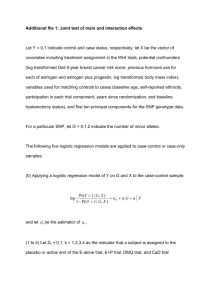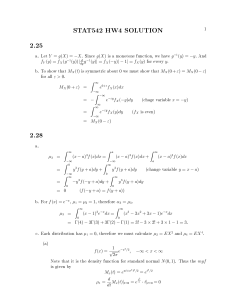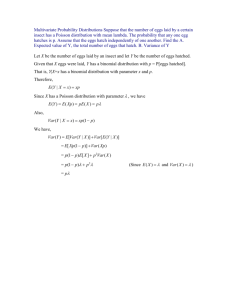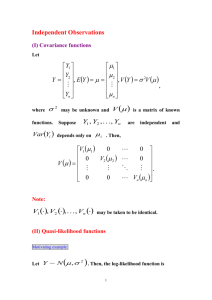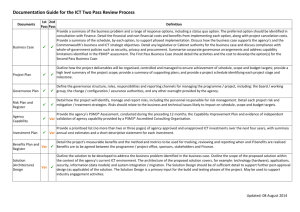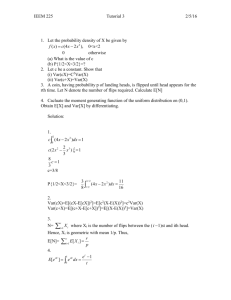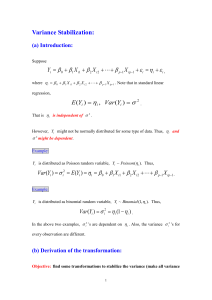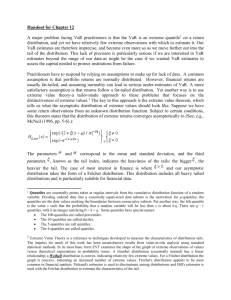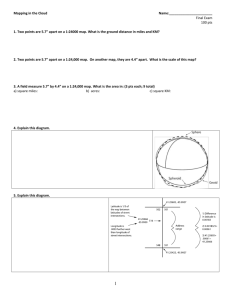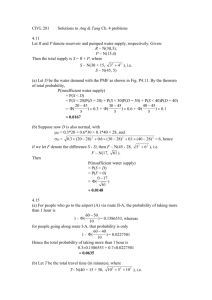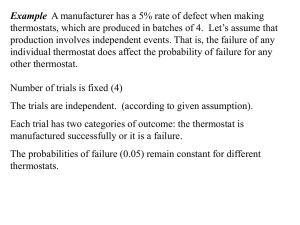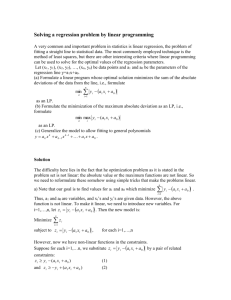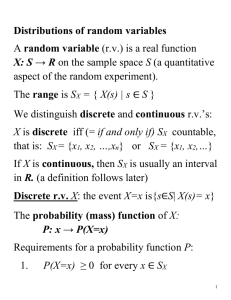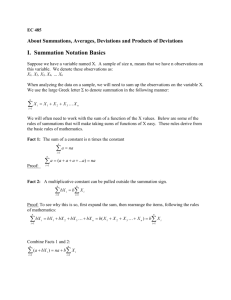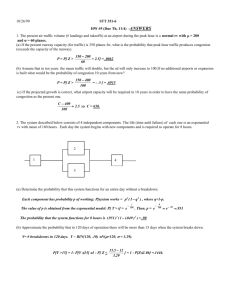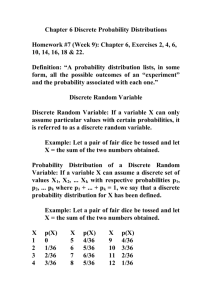Ch5
advertisement
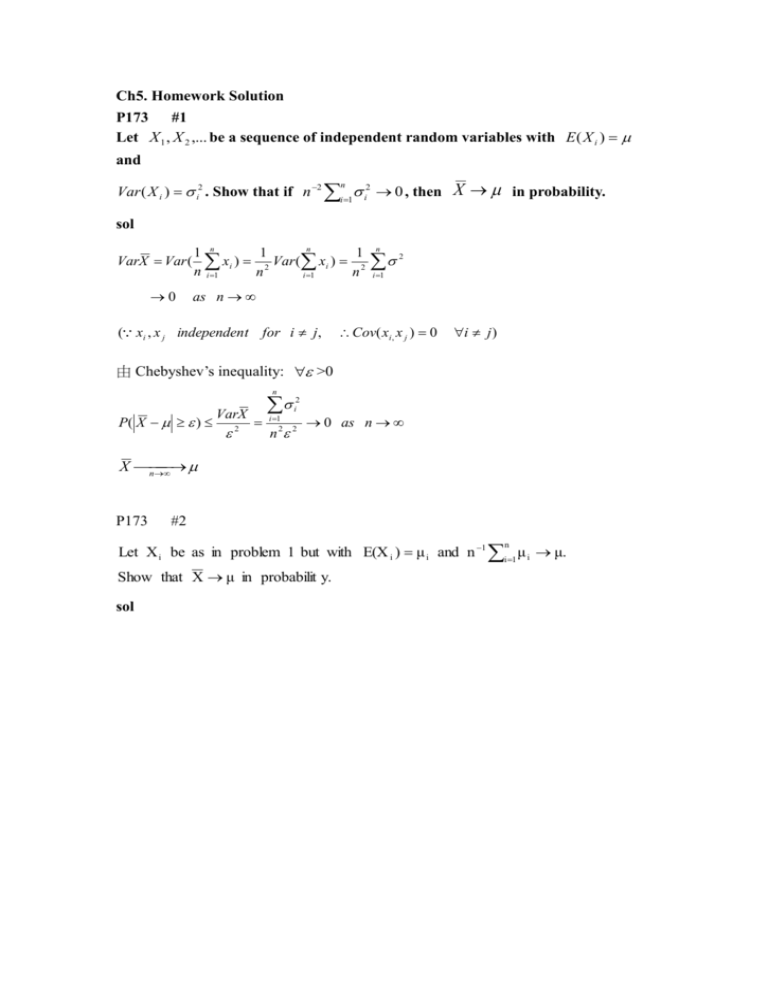
Ch5. Homework Solution
P173 #1
Let X 1 , X 2 ,... be a sequence of independent random variables with E ( X i )
and
Var ( X i ) i2 . Show that if n 2 i 1 i2 0 , then
n
X in probability.
sol
VarX Var (
0
n
1 n
1
1
xi ) 2 Var ( xi ) 2
n i 1
n
n
i 1
n
2
i 1
as n
( xi , x j independen t for i j ,
Cov( xi , x j ) 0
i j )
由 Chebyshev’s inequality: >0
n
P( X )
VarX
2
i 1
2
2
i
n 2
0 as n
X n
P173
#2
Let X i be as in problem 1 but with E(X i ) μ i and n 1 i 1 μ i μ.
n
Show that X μ in probabilit y.
sol
令X i
be a Problem 1. but with EX i μ i and μ n
1 n
μ i , 假定 μ n μ
n i 1
as
由Chebyshev' s inequality : ε 0
n
4 σ i2
Var X n
ε
P( X n μ n )
i21 2 0 as n
ε 2
2
n ε
( )
2
ε
ε 0, δ 0, n 1 Ν s.t. n n 1 P( X n μ n ) δ
2
μ n μ as n
n 2 Ν s.t. n n 2 μ n μ
ε
2
ε
故若能証出n n 2 X n μ ε X n μ n , 則由n max n 1 , n 2
2
ε
P( X n μ ε) P( X n μ n ) δ
2
P
得証 X n n
μ
ε
claim : n n 2 X n μ ε X n μ n
2
假定 X n μ ε, 則n n 2 ε X n μ X n μ n X n μ X n μ n
Xn μn
ε
2
ε
2
ε
因此, n n 2 X n μ ε X n μ n
2
P173 #3
Suppose that the number of insurance claims, N, filed in a year is Poisson
distributed
with E(N)=10,000 . Use the normal approximation to the Poisson to approximate
P(N>10,200).
sol
Let N be a Poisson random var iable with mean 10000, We find
P( N 10200)by s tan dardizing :
N 10000
P( N 10200) P(
10000
10200 10000
10000
) 1 (2) 0.0228
where is the s tan dard normal c.d . f .
6.Using moment-generating functions, show that α the gamma distribution with
parameters α and λ, properly standardized, tends to the standard normal
distribution.
pf﹕X~gamma(α , λ )
M x (t ) =(
t
E(X)=
Var(X)=
2
t<λ
)2
X E( X )
= X
Let Z=
=
Var ( X )
2
X
M z (t ) = e
= e
t
t
Mx(
(
t
)= e
t
t
(
t
)
)
1
1
log M z (t ) t [log 2 log( 2 t )]
1
1
= t log log( 2 t )
2
= t
1
3
1
t2
2
log [ log 2 t 1 2 ( t 3 ) ]
2
2
2
3
1
=
t2
2
2 ( t3)
2
3
→
t2
2
M z (t ) → e
as
t2
2
所以 Z ~ U ( 0 ,1)
14.Answer Problem 13 under the assumption that the drunkard has some idea of
where he wants to go so that he steps north with probability 2/3 and south with
probability 1/3.
Ans:令 X i 為在第 i 分鐘內的位移(以北為正向以南為負向)
P( X i =50)=2/3
P( X i = - 50)=1/3
E( X i ) =50×(2/3)+(- 50)×(1/3)=50/3
E( X i ) 50 2 (2 / 3) (50) 2 (1 / 3) 2500
Var( X i )= E ( X i2 ) [ E ( X i )] 2 20000 / 9
60
S 60 = X i
i 1
令 Zn =
Sn i
n
=
S 60 (50 / 3) 60
60 (20000 / 9)
~ N (0 , 1) by C.L.T.
所以 S 60 ~(1000 , 400000/3)
最有可能在原位置北方 1000cm
1
19.Use the Monte Carlo method with n=100and n=1000 to estimate
cos(2X )dx .
0
Compare the estimates to the exact answer.
Ans: Iˆ( f )
1 1000
cos( 2xi)
1000 i 1
1
I ( f ) c o s2(x)dx
0
Assume X i ~U(0 ,1) iid f( xi ) iid
I ( f ) =E(f(x))
Iˆ
1 1000
f ( xi )
1000 i 1
1
1
1
1
1
1
f ( x)dx c o s2(x)dx
c o s2(x)d (2x) s i n2(x)
2 0
2
0
0
E ( f ( x))
0
=0
1
1
0
0
1 c o s4x
dx
2
0
1
Var ( f ( x)) ( f ( x) 0) 2 dx c o 2s(2x)dx
1
x 1
= sin( 4x) =1/2
2 8
0
P( Iˆ( f ) I ( f ) ) P( Iˆ( f ) I ( f ) ) P(
1000 / 2
Iˆ( f ) I ( f )
1000 / 2
1000 / 2
22.Using th central limit theorem to find △ such that P(∣ Iˆ (f)-I(f)∣≦ △ )=
0.05, where Iˆ (f) is the Monte Carlo estimate of
1
cos(2X )dx
based on 1000
0
points.
Ans: X 1 , X 2 ,... X 1000 ~ U (0 ,1) 且獨立
令 Y=f(x)=cos(2πx) and Y1,Y2,……,Y1000 獨立
1 n
Iˆ( f ) Yi Yn
n i 1
1
E (Y ) E ( f ( x)) cos( 2x)dx I ( f ) 0 E (Y ) E (Y )
0
c o s4(x) 1
1
dx
2
2
0
1
1
E (Y ) E[( f ( x)) ] c o s 2(x)dx
2
2
2
0
Var(X i )=1/2
By C.L.T
Zn=
Yn E (Yn )
Var (Yn )
Iˆ( f ) I ( f )
Var (Y ) / n
Iˆ( f ) I ( f )
1 / 2000
~ N (0 ,1)
故
P( Iˆ( f ) I ( f ) ) P( Iˆ( f ) I ( f ) ) P(
1 / 2000
Iˆ( f ) I ( f )
1 / 2000
( 2000) ( 2000) 2 ( 2000 ) 1 0.05
( 2000) 0.525 2000 0.0 6 2 7
5 0.0 0 1 4 0 3 1 3 3
27.Prove that if a n a
,then (1+ a n
/ n) n e a .
Pf:令 f n (x) (=(1+( x / n)) 2 e x f ( x)為一連續函 數
1 / 2000
)
)
P
an
a 0 P( a n a ) ) 0
f 在 x a 連續 0, 0, st 0 x a f ( x) f (a)
{ f ( x) f (a) } { x a
故 0. P( f (a n ) f (a) ) P( a n a ) 0
P
P
即 f (a n )
f ( a ) e an
ea
(1
an n P
)
e a
n



